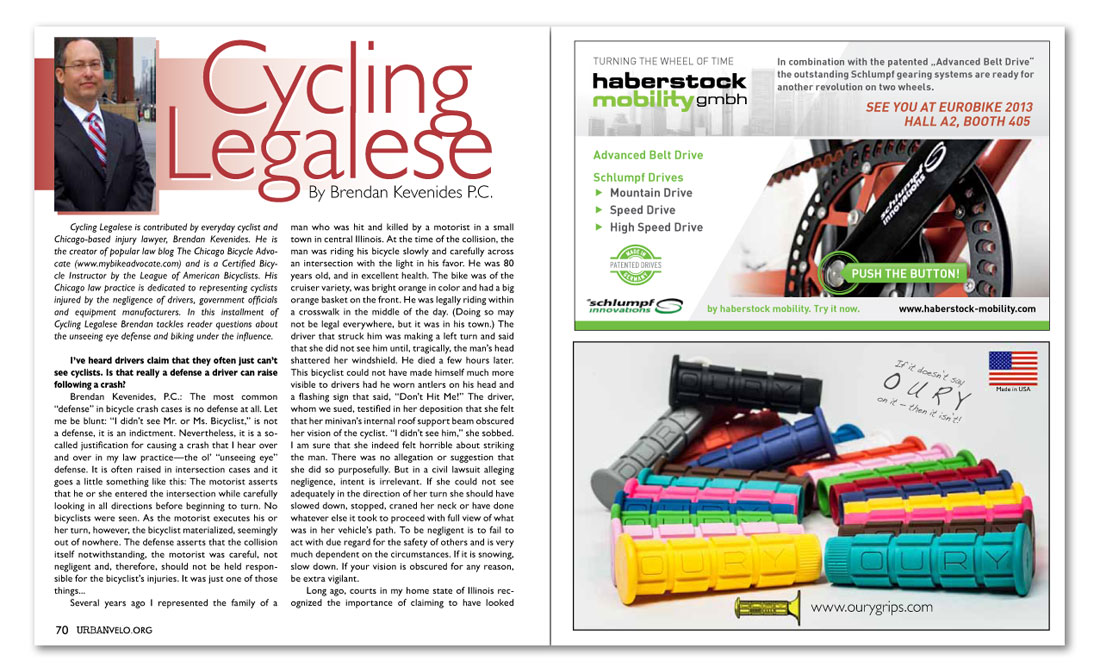


Cycling Legalese
Cycling Legalese is contributed by everyday cyclist and Chicago-based injury lawyer, Brendan Kevenides. He is the creator of popular law blog The Chicago Bicycle Advocate (www.mybikeadvocate.com) and is a Certified Bicycle Instructor by the League of American Bicyclists. His Chicago law practice is dedicated to representing cyclists injured by the negligence of drivers, government officials and equipment manufacturers. In this installment of Cycling Legalese Brendan tackles reader questions about the unseeing eye defense and biking under the influence.
I’ve heard drivers claim that they often just can’t see cyclists. Is that really a defense a driver can raise following a crash?
Brendan Kevenides, P.C.: The most common “defense” in bicycle crash cases is no defense at all. Let me be blunt: “I didn’t see Mr. or Ms. Bicyclist,” is not a defense, it is an indictment. Nevertheless, it is a so-called justification for causing a crash that I hear over and over in my law practice—the ol’ “unseeing eye” defense. It is often raised in intersection cases and it goes a little something like this: The motorist asserts that he or she entered the intersection while carefully looking in all directions before beginning to turn. No bicyclists were seen. As the motorist executes his or her turn, however, the bicyclist materialized, seemingly out of nowhere. The defense asserts that the collision itself notwithstanding, the motorist was careful, not negligent and, therefore, should not be held responsible for the bicyclist’s injuries. It was just one of those things...
Several years ago I represented the family of a man who was hit and killed by a motorist in a small town in central Illinois. At the time of the collision, the man was riding his bicycle slowly and carefully across an intersection with the light in his favor. He was 80 years old, and in excellent health. The bike was of the cruiser variety, was bright orange in color and had a big orange basket on the front. He was legally riding within a crosswalk in the middle of the day. (Doing so may not be legal everywhere, but it was in his town.) The driver that struck him was making a left turn and said that she did not see him until, tragically, the man’s head shattered her windshield. He died a few hours later. This bicyclist could not have made himself much more visible to drivers had he worn antlers on his head and a flashing sign that said, “Don’t Hit Me!” The driver, whom we sued, testified in her deposition that she felt that her minivan’s internal roof support beam obscured her vision of the cyclist. “I didn’t see him,” she sobbed. I am sure that she indeed felt horrible about striking the man. There was no allegation or suggestion that she did so purposefully. But in a civil lawsuit alleging negligence, intent is irrelevant. If she could not see adequately in the direction of her turn she should have slowed down, stopped, craned her neck or have done whatever else it took to proceed with full view of what was in her vehicle’s path. To be negligent is to fail to act with due regard for the safety of others and is very much dependent on the circumstances. If it is snowing, slow down. If your vision is obscured for any reason, be extra vigilant.
Long ago, courts in my home state of Illinois recognized the importance of claiming to have looked
Haberstock Mobility
Oury Grips